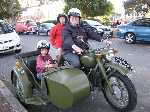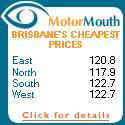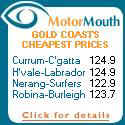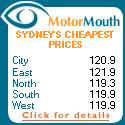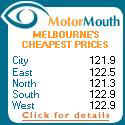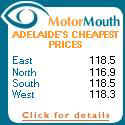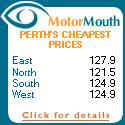1964 Yamaha YA6 "Santa Barbara" 125cc Rotary-valve Single
December 1964 to February 1966
My first "brand new" motorbike.
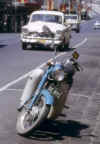 In December 1964, my Dad could see that I was thoroughly hooked on riding
motorbikes so he agreed to help me trade in my faithful old BSA on a brand spanking new
shiny blue Yamaha YA6 125cc Rotary Valve single. For those who don't remember rotary
valves, these engines were two-cycle (two stroke) and the transfer ports and exhaust ports
were opened and closed by the piston as in a normal two-stroke. The difference was
that the carburettor was mounted inside the crankcase cover where it fed through a rotary
disc valve mounted on the end of the crankshaft. This allowed very precise and
adjustable intake timing of the fuel-air mixture into the crankcase ... something that was
just not possible with a "normal" two-stroke where the inlet port was uncovered
by the lower skirt of the piston as it went upward on each stroke. This arrangement
meant that a great deal more power could be wrung out of a small engine and that it had
better fuel consumption than a regular two-stroke. The registration number was
DC-895.
In December 1964, my Dad could see that I was thoroughly hooked on riding
motorbikes so he agreed to help me trade in my faithful old BSA on a brand spanking new
shiny blue Yamaha YA6 125cc Rotary Valve single. For those who don't remember rotary
valves, these engines were two-cycle (two stroke) and the transfer ports and exhaust ports
were opened and closed by the piston as in a normal two-stroke. The difference was
that the carburettor was mounted inside the crankcase cover where it fed through a rotary
disc valve mounted on the end of the crankshaft. This allowed very precise and
adjustable intake timing of the fuel-air mixture into the crankcase ... something that was
just not possible with a "normal" two-stroke where the inlet port was uncovered
by the lower skirt of the piston as it went upward on each stroke. This arrangement
meant that a great deal more power could be wrung out of a small engine and that it had
better fuel consumption than a regular two-stroke. The registration number was
DC-895.
 Here's the whole picture from
which the one above was cropped. The YA6 is parked just near the bridge of Bridge
Street Ballarat and one of Ballarat's historic old trams is lumbering towards us.
Those were the days when the trams were our public transport running every few minutes,
all day long, on about seven or eight different routes, instead of being confined to a
short strip along the edge of Lake Wendouree on Sundays only. This shot was taken on
8th January 1966.
Here's the whole picture from
which the one above was cropped. The YA6 is parked just near the bridge of Bridge
Street Ballarat and one of Ballarat's historic old trams is lumbering towards us.
Those were the days when the trams were our public transport running every few minutes,
all day long, on about seven or eight different routes, instead of being confined to a
short strip along the edge of Lake Wendouree on Sundays only. This shot was taken on
8th January 1966.
 The Yamaha YA6 was
the first model to feature Yamaha's dramatic new "Autolube" system.
Two-stroke oil was kept in a separate oil tank from which a pump caused a steady but
miniscule amount to kind of "ooze" into the bike's intake chamber (where the
rotary valve was located). From the valve chamber it was carried into the crankase
with the charge of fuel-air mixture where it lubricated the innards more by luck than
management, just like any other two-stroke engine. The Autolube system meant that
you never had to mix oil with the petrol and since the pump was controlled both by the
speed of the engine as well as the throttle cable, it theoretically pumped in exactly the
right amount to keep the engine well lubricated without the haze of blue smoke that
followed the typical two-stroke in those days. In the picture at the right (click on
thumbnail for a good view) you can see the layout of how the system worked. As the
oil pump was critical to this system, the manual called for frequent checking and I soon
became adept at tuning it very precisely, so that the engine was always well-lubricated
but so that I never saw any blue smoke unless I pulled on the oil-pump cable with my hand
to make it out-of-synch with the throttle cable.
The Yamaha YA6 was
the first model to feature Yamaha's dramatic new "Autolube" system.
Two-stroke oil was kept in a separate oil tank from which a pump caused a steady but
miniscule amount to kind of "ooze" into the bike's intake chamber (where the
rotary valve was located). From the valve chamber it was carried into the crankase
with the charge of fuel-air mixture where it lubricated the innards more by luck than
management, just like any other two-stroke engine. The Autolube system meant that
you never had to mix oil with the petrol and since the pump was controlled both by the
speed of the engine as well as the throttle cable, it theoretically pumped in exactly the
right amount to keep the engine well lubricated without the haze of blue smoke that
followed the typical two-stroke in those days. In the picture at the right (click on
thumbnail for a good view) you can see the layout of how the system worked. As the
oil pump was critical to this system, the manual called for frequent checking and I soon
became adept at tuning it very precisely, so that the engine was always well-lubricated
but so that I never saw any blue smoke unless I pulled on the oil-pump cable with my hand
to make it out-of-synch with the throttle cable.
Spark plugs and melted pistons:
The spark plug installed in the bike when it was new was made by NGK, a brand which nobody anywhere had ever heard of in Australia in those days. Every once in a while the plug would get bridged by a tiny bit of grit and when it did so, the bike would roll to a stop. Each time it only took a moment or two to pull out the plug, clean it and put it back and we were soon away again. However, I decided that it would be wise to carry a spare plug in my toolkit. I checked in the rider's manual and the only advice it gave was to fit an NGK plug. It showed pretty pictures of wet plugs, oily plugs, dried and blistered plugs and nice tan clean plugs and suggested which NGK plug should be fitted depending upon the condition of your original plug. I stopped at motor garages and most had never heard of a Yamaha. They could tell me what plugs to put in every model of BSA, Triumph, Norton, Indian or Harley, but a Yamaha was an absolutely unknown quantity. Eventually, in January 1965, I found a plug dealer somewhere who actually had the name "Yamaha" in his plug catalogue. The only models listed were "Twin" and "Single" and since mine was a single, I bought the recommended Champion brand plug. The next day, on Port Arlington Road near Point Henry, the original plug fouled, so I pulled it out and inserted the new one from my toolkit. As I crossed on a back road towards the Queenscliffe Road, I noticed that my motor was making a kind of "tinny" noise. A few minutes later, on the back road between Drysdale and St Leonards, the engine suddenly stopped firing but the normal engine braking effect was completely absent ... the bike just rolled on and on down the hill with the engine turning over but no sign of exhaust noise. I phoned my dad who was at Indented Head that day and he advised me to take the head off and look at the piston. When I did so, I found an enormous hole straight through the middle of the top of the piston. It turned out that the Champion plug was of the wrong heat range and that the "tinny" noise I had heard was called "detonation" and that the whole time that noise was present the aluminium of the piston had been melting away and getting blown out through the exhaust port and into the exhaust pipe which was now neatly lined with shiny aluminium. The bike was fitted with a new piston and I bought half a dozen shiny new NGK plugs of the correct heat range from Pratt & Osborne Motors in Geelong. I had learned an expensive lesson about two-stroke engines: they were extremely fussy about what kind of spark plugs you put into them.
About two-stroke oils:
The manual for the YA6 told me that I must never use any oil other than "Genuine Yamaha Autolube Oil" in my bike. Now I have a tendency to be a bit of a pedantic perfectionist when it comes to obeying manuals. However I soon learned it was impossible to purchase "Genuine Yamaha Autolube Oil" anywhere around the places I was likely to ride. Occasionally I was able to find "Two Stroke Oil" or "Outboard Oil" both of which tended to be outrageously expensive. My Dad told me that in his day, everyone with a two-stroke just added plain cheap old run-of-the-mill, ordinary, everyday SAE 30 oil to their petrol tanks and hoped they were adding the correct amounts. I decided that since Dad often knew what he was talking about, that I would try running the Yamaha on SAE 30 oil. It never missed a beat. I kept accurate records in a Shell Driver's Log Book of all the oil and petrol I bought and after a while I was able to calculate that the Autolube pump was doling out the oil at an average petrol to oil ratio of around 50 to 1, so it was certainly far more economical than mixing the oil with the petrol in the fuel tank. In retrospect, I realise that it was also very much more environmentally friendly than two-strokes running on premix, although nobody really thought about such matters back in those days.
Polishing the cylinder fins!
In those early motorcycling days, I always seemed to have a lot more time on my hands than I do today. A lot of this excess time was spent cleaning and polishing the little motorbike. The whole bike looked gleaming and shiny, but the fins on the cylinder looked kind of dull. Therefore I decided to polish up the outside of the cylinder. A television advertisement back in those days showed a bloke polishing his car (a street Hot Rod) engine with Johnsons Duraglo floor polish. I figured if it would polish the engine of a car, it could also polish the engine of a motorbike. Thus it happened that one day I "borrowed" my mum's can of Duraglo and took it out to the motorbike shed. For a couple of weeks, I did the same trick and you could see your face in each one of the fins of that engine. One day I had the bike at the local motorbike shop for some reason when the chief mechanic told me, "This engine is running too hot." He got down and took a squiz and exclaimed, "What the hell has happened to your cylinder fins?" I told him I had polished them to make them nice and shiny. He told me that the cast iron fins would radiate the heat into the atmosphere much more efficiently if they were not polished. I knew from the manual that the cylinder consisted of an iron sleeve pressed in to an aluminium barrel, but what he told me made sense when I thought back to my high school Physics classes. So then it was back to work using lots of elbow-grease to remove the Duraglo from the outside of that cylinder. Somehow it did seem to run consistently cooler after that. Another lesson learned.
Memories from the YA6 era:
This bike was the first one I was able to go longer distances on. Only half of
the capacity of the BSA but much faster and more reliable. The memories thinking of
this bike brings back are:
- Christmas holidays when I rode it to my Grandmother's place at Indented Head.
Family get-togethers and watching the movies under the stars on the beach.
- Going on it to visit the Hiorth family on the farm at Wallington. Taking lots of
photos there because they had a flower farm and I was experimenting with my new camera.
Haven't a clue where all those old colour slides would be now ...
- Riding it to East Sale to watch the air displays. I loved being close to planes in
those days as well. Now I am too close to planes too often: in the last year or so I
have been in Hong Kong, Vietnam, Australia, Philippines, Thailand, Taiwan, Malaysia,
Singapore and probably other places I have forgotten. Riding the Yamaha around
Victoria was a lot more fun. Life was a lot less complicated.
- Long rides from Tyers to Ballarat nearly every Friday and back again nearly every Sunday
... counting mileposts so I didn't go to sleep while driving ... making up songs about the
next towns along the road and singing them to myself in my helmet to try to stay awake ...
coming across far too many bad truck accidents on the Western Highway - good reminders to
stay awake ... the beautiful avenues of trees in Bacchus Marsh and Ballarat where the
seasons were so marked by the changing of the trees.
The YA6 was used to commute between my parent's home in Ballarat and my work in Traralgon and made frequent visits to Geelong and Melbourne as well as turning up in various parts of country Victoria on all sorts of odd occasions, so it ran up well over a thousand miles each month. And I started to get sick of a bike that ran so slowly. So it came about one day that we went to Pratt & Osborne Motors in Geelong where, after I had borrowed the money from my Grandpa, I purchased a shiny red and white Yamaha YDS3, registration number DH-528, if I recall it correctly.
2006-12-29
NOTE: If you know of any links which you think should be added to this page, or if you find that some of the links on this page do not work, or if links now lead to unsuitable content, please email me at phil DOT drdisk AT gmail DOT com to advise me of the details.
This page was last updated on 07/02/08 at 07:20:11 Hong Kong Time.
You are visitor number (total hits to all pages in this web-site) since 24th June
1997.
Copyright © 1996 - 2010 Phil Smith, all rights reserved. All contents in this web site are provided as is without warranty of any kind. Phil Smith expressly disclaims any liability from the use of any information in this web site.
Note: for sections of some of the pages within this site attributed to [HKO]: the links and materials provided therein are supplied by the Hong Kong Observatory and the following Notice is applicable to those sections: Copyright Notice: All weather information shown here, including but not limited to all text, graphics, drawings, diagrams, photographs and compilation of data or other materials are provided by the Hong Kong Observatory. Any reproduction, adaptation, distribution, dissemination or making available of such copyright works to the public is strictly prohibited unless prior written authorization is obtained from the Hong Kong Observatory.
Note that the e-mail address for Phil Smith (also known as "Doctor Disk") has been changed to phil DOT drdisk AT gmail DOT com with effect from 18th March 2006. To use this e-mail address, in your e-mail program's "To" field, type out the words in blue replacing " AT " with "@" and replacing " DOT " with "." so that there are no spaces. Sorry for the inconvenience, but my junk mail had passed 1,000 items per day.
 |
